
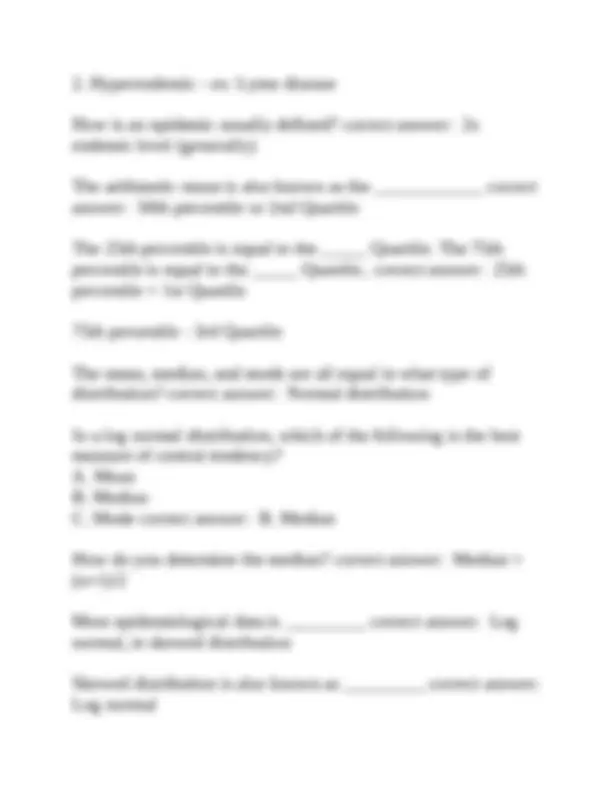
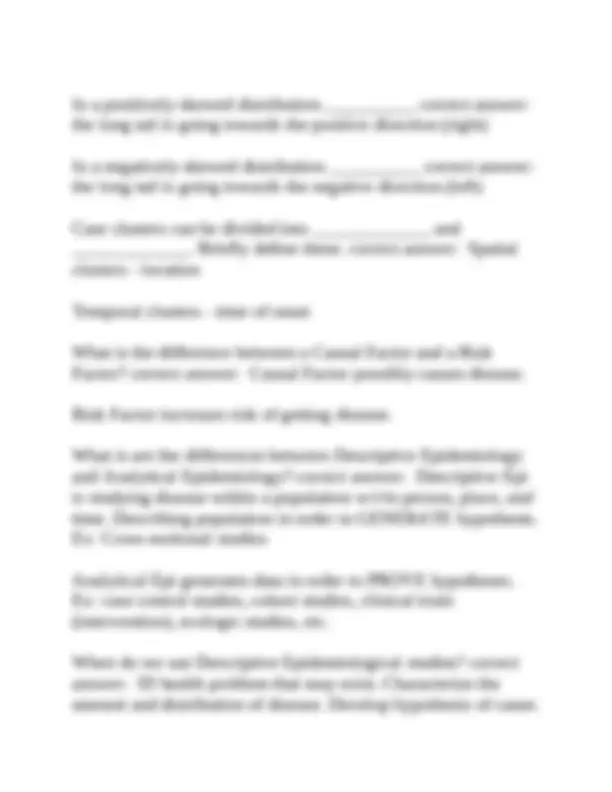
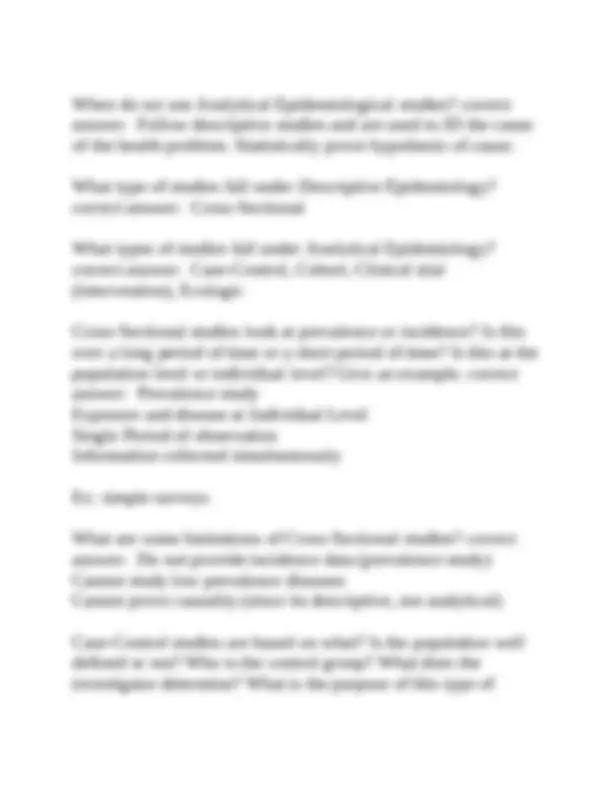
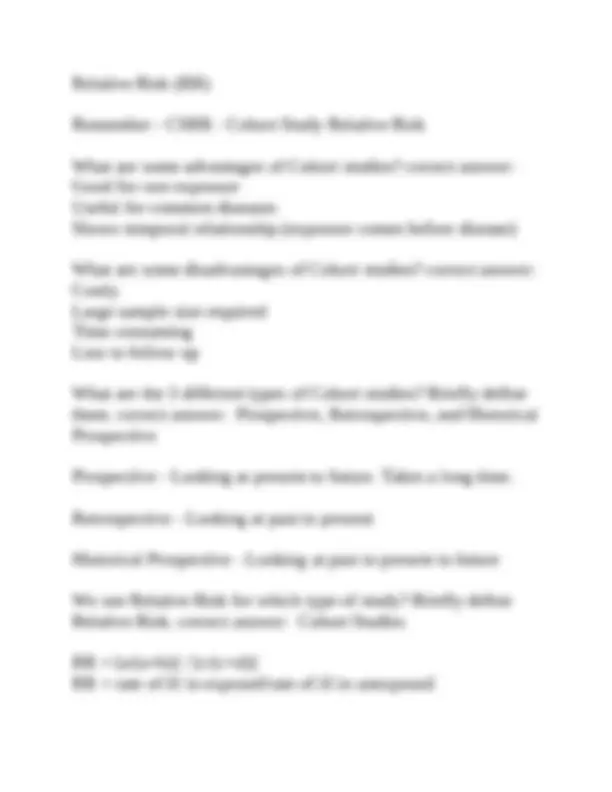
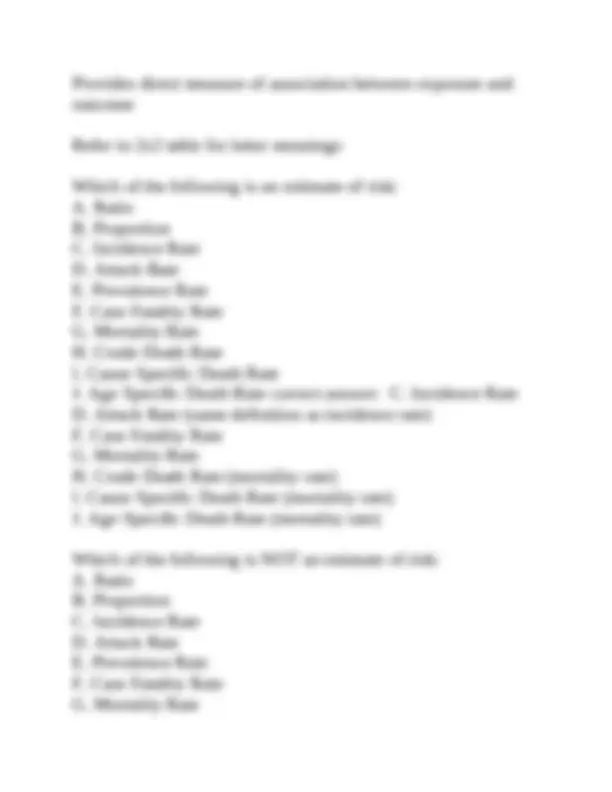
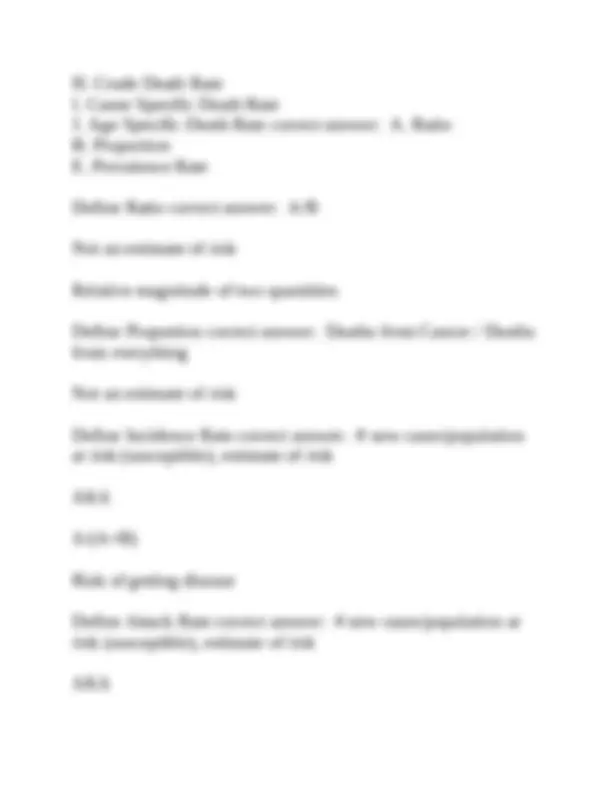
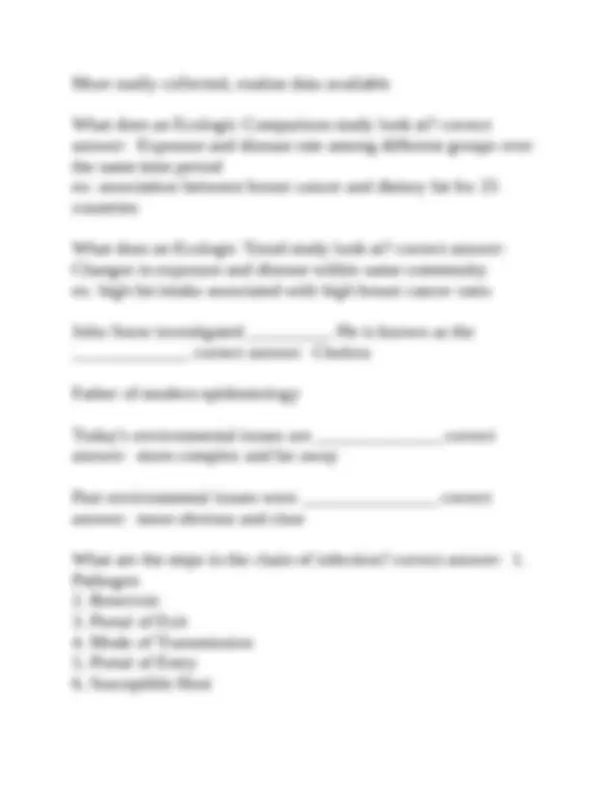
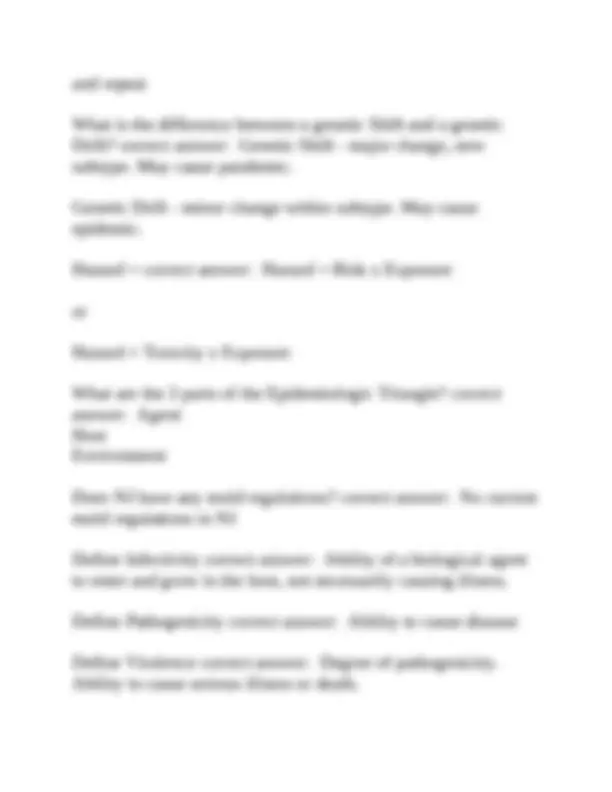
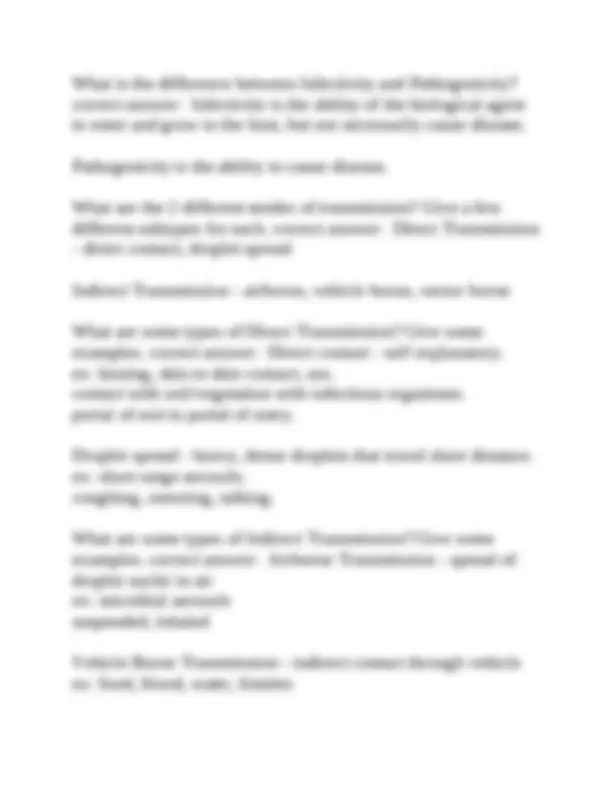
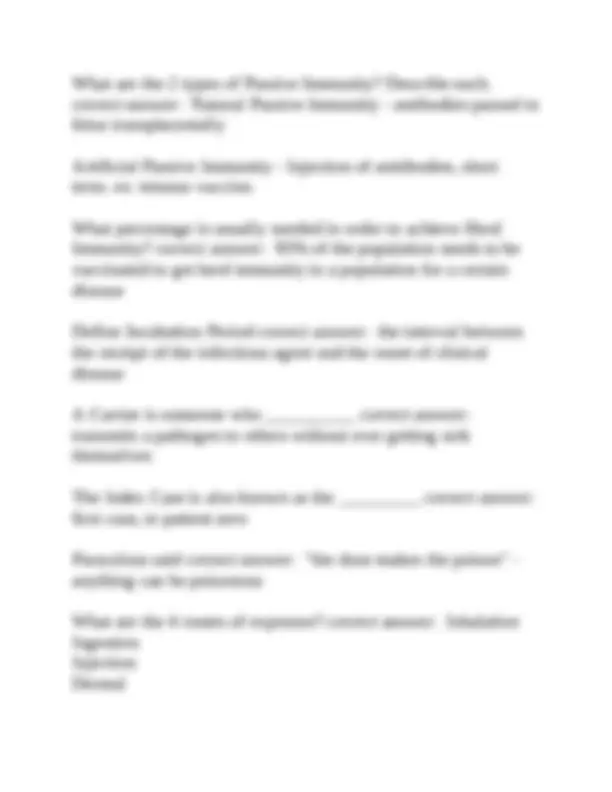
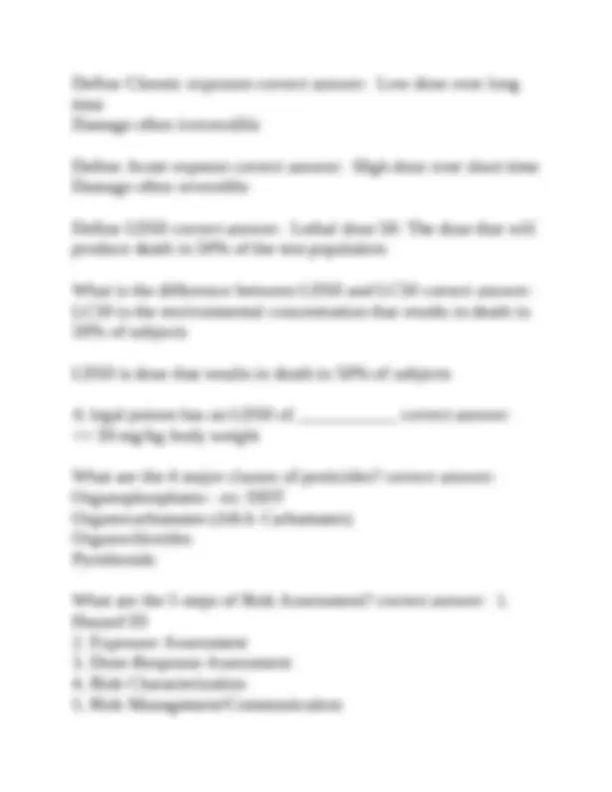
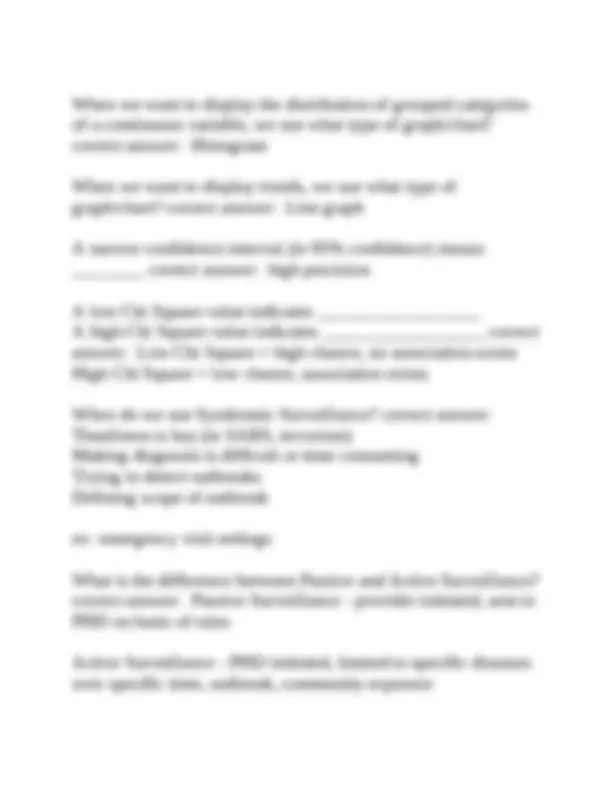
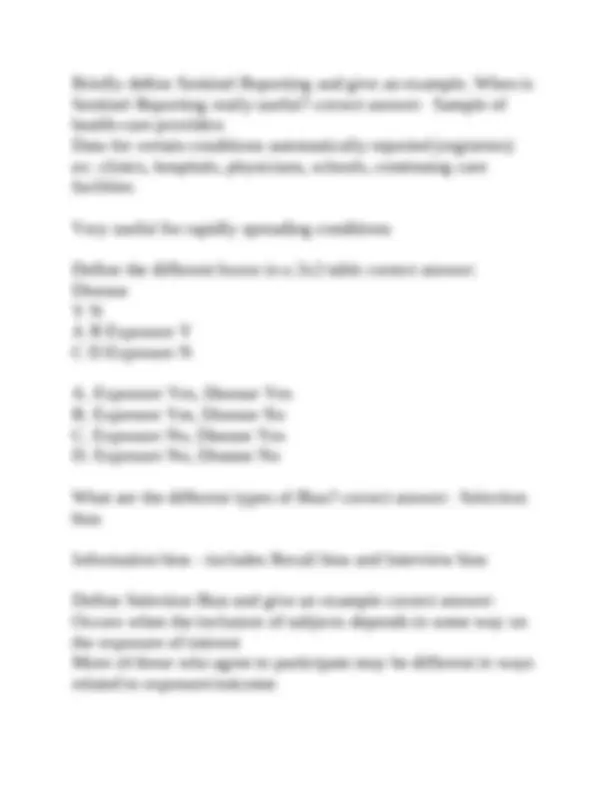
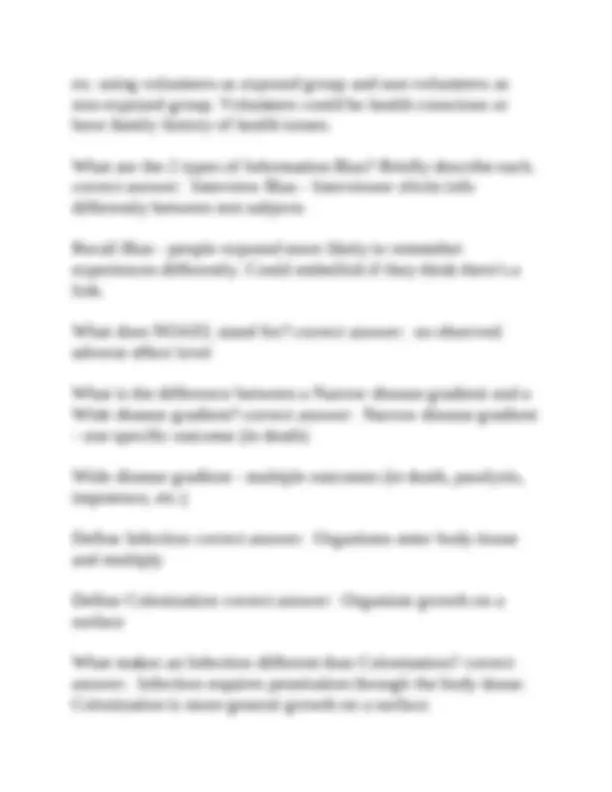
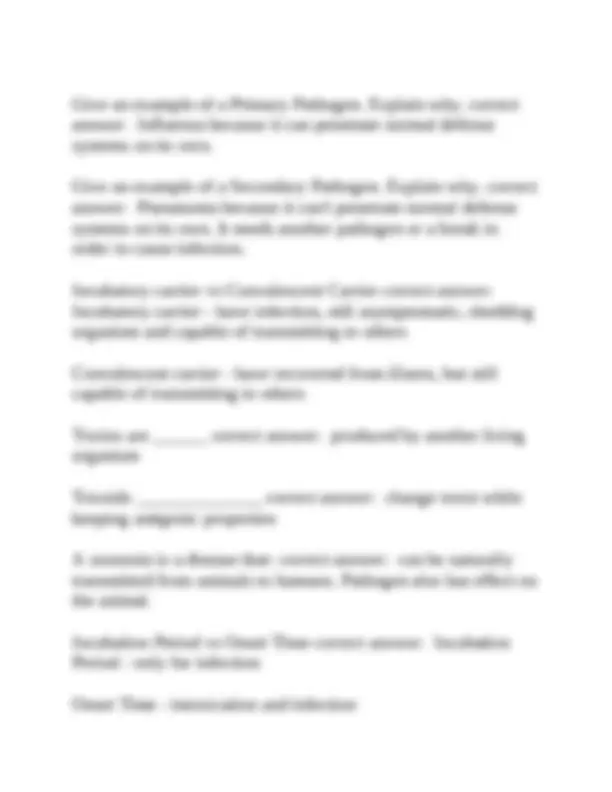
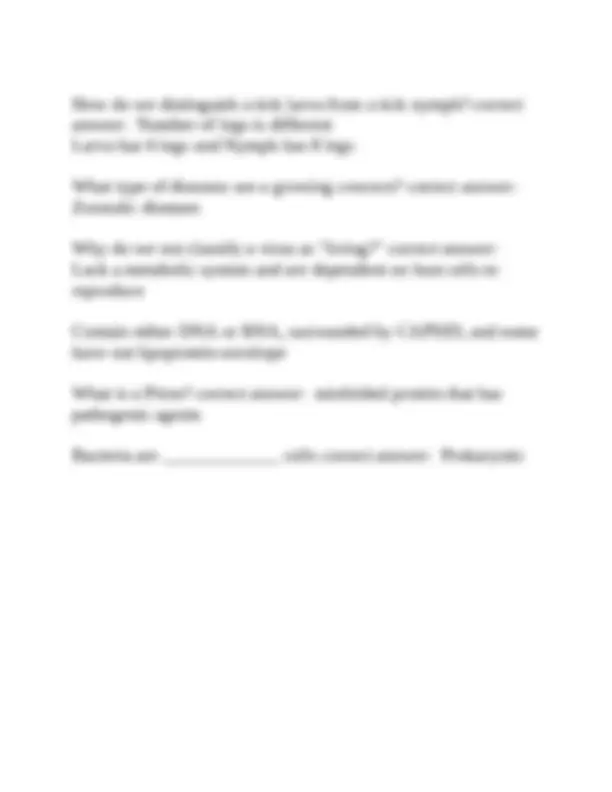


Study with the several resources on Docsity

Earn points by helping other students or get them with a premium plan


Prepare for your exams
Study with the several resources on Docsity

Earn points to download
Earn points by helping other students or get them with a premium plan
Community
Ask the community for help and clear up your study doubts
Discover the best universities in your country according to Docsity users
Free resources
Download our free guides on studying techniques, anxiety management strategies, and thesis advice from Docsity tutors
A comprehensive set of exam questions and answers related to epidemiology and communicable diseases. It covers key concepts such as cohort studies, case-control studies, primary, secondary, and tertiary prevention, endemic and epidemic definitions, and measures of central tendency. The document also includes explanations of various epidemiological study designs, their advantages and limitations, and the calculation of odds ratios and relative risks. It is a valuable resource for students studying public health, epidemiology, or related fields.
Typology: Exams
1 / 24

This page cannot be seen from the preview
Don't miss anything!

















A Cohert Study is characterized by: correct answer: Group of exposed individuals who can easily be identified Allows for comparison of risk by what was and was not eaten ex: wedding A Case-Control Study is characterized by: correct answer: Exposed group that is very large or not easily identified Compares ill with non-ill to determine the likelihood of having eaten a specific food ID's possible causes of disease by seeing how two groups differ w/r/to some exposure factor When do we generally determine a disease outbreak to be over? correct answer: 2 incubation periods after last reported infection Define primary prevention. Give some examples. correct answer: Prevent illness or injury from occurring at all ex: Vaccines, PPE, fluoride in water, vitamin fortified foods, smoking cessation, educational campaigns against accidents Define secondary prevention. Give an example. correct answer: Seeks to minimize severity of illness or injury. This occurs during the pathogenesis phase. ex: screening programs fro cancer and diabetes
Define Tertiary prevention. Give an example. correct answer: Seeks to minimize disability through medical care and rehabilitation services ex: physical therapy for stroke patients, halfway houses for alcohol abuse recovery, fitness programs for heart attack patients Vaccines are considered A. Primary prevention B. Secondary prevention C. Tertiary prevention correct answer: A. Primary prevention because they are trying to prevent disease all together What is the difference between Active Primary prevention and Passive Primary prevention? correct answer: Active - necessitate behavior change on part of subject ex: vaccination and wearing protective devices Passive - doesn't require behavior change ex: fluoride in drinking water, vitamin fortified milk and bread An outbreak is defined as ____________________ correct answer: incident with 2 or more people sick from same illness from the same source Define endemic. What are the two different types of endemics? Define those. correct answer: Level of disease regularly found within a population or in a certain area
In a positively skewed distribution __________ correct answer: the long tail is going towards the positive direction (right) In a negatively skewed distribution __________ correct answer: the long tail is going towards the negative direction (left) Case clusters can be divided into _____________ and _____________. Briefly define these. correct answer: Spatial clusters - location Temporal clusters - time of onset What is the difference between a Causal Factor and a Risk Factor? correct answer: Causal Factor possibly causes disease. Risk Factor increases risk of getting disease. What is are the differences between Descriptive Epidemiology and Analytical Epidemiology? correct answer: Descriptive Epi is studying disease within a population w/r/to person, place, and time. Describing population in order to GENERATE hypothesis. Ex: Cross-sectional studies Analytical Epi generates data in order to PROVE hypotheses. Ex: case control studies, cohort studies, clinical trials (intervention), ecologic studies, etc. When do we use Descriptive Epidemiological studies? correct answer: ID health problem that may exist. Characterize the amount and distribution of disease. Develop hypothesis of cause.
When do we use Analytical Epidemiological studies? correct answer: Follow descriptive studies and are used to ID the cause of the health problem. Statistically prove hypothesis of cause. What type of studies fall under Descriptive Epidemiology? correct answer: Cross-Sectional What types of studies fall under Analytical Epidemiology? correct answer: Case-Control, Cohort, Clinical trial (intervention), Ecologic Cross-Sectional studies look at prevalence or incidence? Is this over a long period of time or a short period of time? Is this at the population level or individual level? Give an example. correct answer: Prevalence study Exposure and disease at Individual Level Single Period of observation Information collected simultaneously Ex: simple surveys What are some limitations of Cross-Sectional studies? correct answer: Do not provide incidence data (prevalence study) Cannot study low prevalence diseases Cannot prove causality (since its descriptive, not analytical) Case-Control studies are based on what? Is the population well defined or not? Who is the control group? What does the investigator determine? What is the purpose of this type of
OR = (a/c) / (b/d) OR = odds in favor of exposure among cases/odds in favor of exposure among controls Refer to 2x2 table for letter meanings Define confounding factor correct answer: Other risk factor that can also cause disease A. When Relative Risk or Odds Ratio > 1 B. When Relative Risk or Odds Ratio = 1 C. When Relative Risk or Odds Ratio < 1 correct answer: A. Positive Association (it likely increases risk for illness) B. No significant difference C. Negative Association (exposure is protective against illness) What is the question we should be asking ourselves when talking about Cohort studies? What do Cohort studies show? correct answer: Who are my people that are exposed? Going from cause (exposure) to effect Cohort studies are based on what? Is the population well defined or not? What does the investigator determine? Who is the control group? Do we use Relative Risk or Odds Ratio to measure association? correct answer: Exposure status - tracking exposed and unexposed participants and seeing if they develop disease of interest Population is well defined Investigator determines ill/not ill based on case definition Control group is unexposed participants
Relative Risk (RR) Remember - CSRR - Cohort Study Relative Risk What are some advantages of Cohort studies? correct answer: Good for rare exposure Useful for common diseases Shows temporal relationship (exposure comes before disease) What are some disadvantages of Cohort studies? correct answer: Costly Large sample size required Time consuming Loss to follow up What are the 3 different types of Cohort studies? Briefly define them. correct answer: Prospective, Retrospective, and Historical Prospective Prospective - Looking at present to future. Takes a long time. Retrospective - Looking at past to present Historical Prospective - Looking at past to present to future We use Relative Risk for which type of study? Briefly define Relative Risk. correct answer: Cohort Studies RR = [a/(a+b)] / [c/(c+d)] RR = rate of ill in exposed/rate of ill in unexposed
H. Crude Death Rate I. Cause Specific Death Rate J. Age Specific Death Rate correct answer: A. Ratio B. Proportion E. Prevalence Rate Define Ratio correct answer: A/B Not an estimate of risk Relative magnitude of two quantities Define Proportion correct answer: Deaths from Cancer / Deaths from everything Not an estimate of risk Define Incidence Rate correct answer: # new cases/population at risk (susceptible), estimate of risk AKA A/(A+B) Risk of getting disease Define Attack Rate correct answer: # new cases/population at risk (susceptible), estimate of risk AKA
Risk at specific time, shorter term than incidence rate time frame. Define Prevalence Rate correct answer: # total cases (new & pre-existing)/population (can be average pop or total number in a group), not an estimate of risk Define Case Fatality Rate correct answer: # dead from AIDS / # diagnosed with AIDS Estimate of risk What percent of people die from this disease? What is an age adjusted rate? correct answer: Remove certain age groups from your analysis to get a more representative age group for the purpose of your study Formula for Cause Specific Death Rate correct answer: (Death from A / Total Population at risk) x 100, Define Range correct answer: difference between largest and smallest value in data set What is the difference between the Primary Attack Rate and the Secondary Attack Rate? Define Secondary Attack Rate. correct answer: Primary attack rate looks at incidence from the original source
More easily collected, routine data available What does an Ecologic Comparison study look at? correct answer: Exposure and disease rate among different groups over the same time period ex: association between breast cancer and dietary fat for 25 countries What does an Ecologic Trend study look at? correct answer: Changes in exposure and disease within same community ex: high fat intake associated with high breast cancer rates John Snow investigated _________. He is known as the _____________ correct answer: Cholera Father of modern epidemiology Today's environmental issues are ______________ correct answer: more complex and far away Past environmental issues were _______________ correct answer: more obvious and clear What are the steps in the chain of infection? correct answer: 1. Pathogen
and repeat What is the difference between a genetic Shift and a genetic Drift? correct answer: Genetic Shift - major change, new subtype. May cause pandemic. Genetic Drift - minor change within subtype. May cause epidemic. Hazard = correct answer: Hazard = Risk x Exposure or Hazard = Toxicity x Exposure What are the 3 parts of the Epidemiologic Triangle? correct answer: Agent Host Environment Does NJ have any mold regulations? correct answer: No current mold regulations in NJ Define Infectivity correct answer: Ability of a biological agent to enter and grow in the host, not necessarily causing illness. Define Pathogenicity correct answer: Ability to cause disease Define Virulence correct answer: Degree of pathogenicity. Ability to cause serious illness or death.
Vector Borne Transmission - animate insect or animal that transmits disease agents ex: arthropods, rodents, raccoons mechanical & biological What are some common Mosquito-borne diseases? correct answer: West Nile virus Eastern Equine Encephalitis (EEE) Dengue fever Yellow fever St Louis Encephalitis (SLE) What are some common Tick-borne diseases? correct answer: Lyme disease Babesiosis Ehrlichiosis Tularemia Rocky mountain spotted fever Define zoonosis correct answer: a disease that can be transmitted from vertebrate animals to humans What is the difference between Enzootic and Epizootic? correct answer: Enzootic - endemic, but for animals Epizootic - epidemic, but for animals Rabies and Fungal infections are examples of what type of transmission? correct answer: These zoonosis are transmitted via Direct Transmission
EEE and Plague are examples of what type of transmission? correct answer: Indirect, vector borne transmission Salmonella (from food) is an example of what type of transmission? correct answer: Indirect, food borne transmission Giardiasis (from water) is an example of what type of transmission? correct answer: Indirect, waterborne transmission If you were trying to stop the spread of disease by rats, how would you go about controlling the reservoir? correct answer: Collect garbage - they won't come to you Control rate population - no rats, no problem What is the difference between Active Immunity and Passive Immunity? correct answer: Active immunity is administration of microorganism to invoke immune response that mimics natural infection Passive immunity is short-term immunity provided by a pre- formed antibody (produced by another person or animal) What are the 2 types of Active Immunity? Describe each. correct answer: Natural Active Immunity - results from natural exposure to agent Artificial Active Immunity - Vaccination, long duration. ex: MMR vaccine
Define Chronic exposure correct answer: Low dose over long time Damage often irreversible Define Acute expsure correct answer: High dose over short time Damage often reversible Define LD50 correct answer: Lethal dose 50: The dose that will produce death in 50% of the test population What is the difference between LD50 and LC50 correct answer: LC50 is the environmental concentration that results in death in 50% of subjects LD50 is dose that results in death in 50% of subjects A legal poison has an LD50 of ___________ correct answer: <= 50 mg/kg body weight What are the 4 major classes of pesticides? correct answer: Organophosphates - ex: DDT Organocarbamates (AKA Carbamates) Organochlorides Pyrethroids What are the 5 steps of Risk Assessment? correct answer: 1. Hazard ID
When we want to display the distribution of grouped categories of a continuous variable, we use what type of graph/chart? correct answer: Histogram When we want to display trends, we use what type of graph/chart? correct answer: Line graph A narrow confidence interval (ie 95% confidence) means ________ correct answer: high precision A low Chi Square value indicates __________________ A high Chi Square value indicates __________________ correct answer: Low Chi Square = high chance, no association exists High Chi Square = low chance, association exists When do we use Syndromic Surveillance? correct answer: Timeliness is key (ie SARS, terrorism) Making diagnosis is difficult or time consuming Trying to detect outbreaks Defining scope of outbreak ex: emergency visit settings What is the difference between Passive and Active Surveillance? correct answer: Passive Surveillance - provider initiated, sent to PHD on basis of rules Active Surveillance - PHD initiated, limited to specific diseases over specific time, outbreak, community exposure